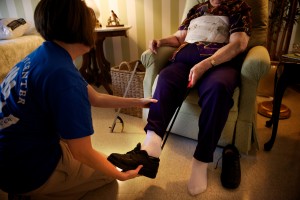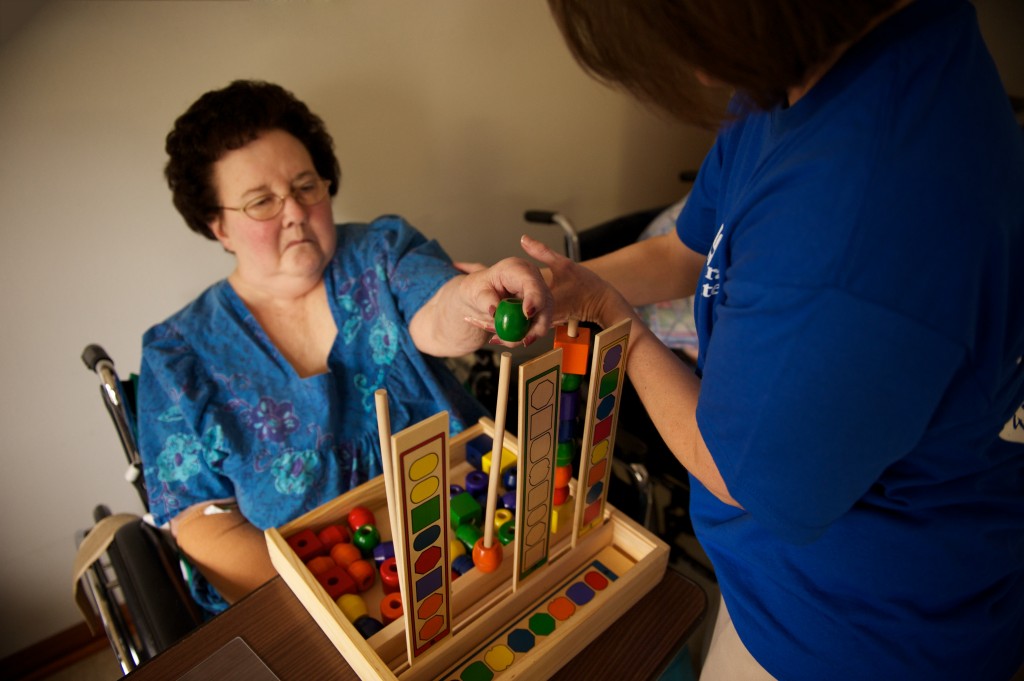April is National Occupational Therapy Month! This article is intended to celebrate the OT profession and provide education on the practice.
Growing up with a dad who is physical therapist, I was somewhat exposed to occupational therapy through my visits to the outpatient clinic where he worked. When I began my job with Therapy Center almost 6 years ago, I realized that I really had no clue what this practice was all about. In my childhood mind, I remember the kind OT who allowed me to bounce on her large exercise ball in the gym and the cool wax machine that my sister and I got to stick our hands in to make cool “wax hands”. Fast forward a few decades later, I am in a marketing career where understanding the skills and roles of occupational therapists is of the utmost importance.
The Difference Between an Occupational Therapist and a Physical Therapist

Many people struggle to understand the difference between an occupational therapist and a physical therapist. I sat down with Lauren Lemoine McCraine, an occupational therapist and Mentor with Therapy Center. She has been with Therapy Center for over 12 years and she was very informative regarding the difference between the two professions.
“The best way to describe the difference between occupational therapist and physical therapist is that PTs will teach you to walk to the kitchen, but OTs will teach you what to do once you get there. OTs are considered holistic therapists, in that we not only treat physical ailments, but we also address the social and psychological aspects of one’s life. We wear many hats on any given day from OT to social worker, patient advocate to nurse, friend, or family,” explains Lauren.
Occupational Therapy in the Skilled Nursing (SNF) Setting
Occupational therapy is defined as the therapeutic practice of everyday actions in order to establish, recover, or maintain a person’s typical daily living activities. Occupational therapists help others to improve their basic motor functions and/or compensate for permanent loss of function.
Occupational Therapy interventions for a short-term SNF stay can include:
- Focusing on activities of daily living (IADLs) related to the patient’s discharge environment, such as preparing a meal or managing one’s home or finances
- Training in functional mobility, such as how to prepare a meal while using equipment such as a walker or cane
- Preparing the client and family for community re-entry with activities such as public dining or emergency response management
- Assessing the need for and recommending potential home modifications and safety equipment to reduce
- Exploring adaptations and compensatory strategies in order to return to work
 Occupational therapy for long-term-care SNF residents can also include:
Occupational therapy for long-term-care SNF residents can also include:
- Teaching functional mobility, including using an ambulatory device and/or transfers to different surfaces, such as a bed, chair, toilet, or shower in order to perform self-care and personal tasks; and training in wheelchair mobility and safety appropriate for the resident’s level of cognition and perception
- Remediating or enhancing IADLs, such as ability to use the telephone or the emergency staff call system
- Teaching residents with cognitive and perceptual deficits in compensatory techniques to maximize abilities in areas such as attention span, orientation, sequencing, and/or memory
- Teaching residents with low vision how to maximize their remaining vision and enhance safety through compensatory techniques, environmental modifications, assistive technology, and adaptive equipment
Common Conditions Occupational Therapists Treat
Within her 12+ years of skilled nursing experience, Lauren tells me that the most common conditions she has worked with include strokes, osteoarthritis, Alzheimer’s disease, Parkinson’s disease, fractures, poor vision, COPD, depression, and age related decline. I wanted to know what types of exercises are commonly incorporated into an OT treatment plan, and what purpose these exercises serve. Just like other therapists, an occupational therapist will conduct assessments and evaluations to determine the areas in which a person may need help. But from there, how does an OT treat these conditions if they aren’t all physical? As Lauren explains it, “The thought behind this is that if an OT can discover an activity that is purposeful and meaningful to someone through conversations or evaluations, then there is more commitment to the task, it’s useful and familiar to the patient in regards to returning to prior level of function, and it can help build rapport between the therapist and patient.” A simple task such as folding clothes while standing is something familiar, yet purposeful to the patient and can help to build motor skills, balance, and range of motion, among other things.
Through my time with Therapy Center, my knowledge about occupational therapy has grown tremendously. I’ve learned that therapists in this field can develop a treatment plan out of almost any daily task; whether it be sweeping a room, putting a golf ball, painting, fishing, writing letters, brushing teeth, and even making coffee, all of these activities are purposeful and meaningful to someone. Occupational therapy truly helps patients, young and old alike, maintain dignity and develop skills that help them live more independently.
Interested in learning more…
To learn more about occupational therapy, visit this link: http://www.aota.org/
Or, if you’re an occupational therapist who is looking to expand your career and learn from the best, please visit our Career Opportunities page.
Article written by Kristi Fredieu, Director of Marketing

